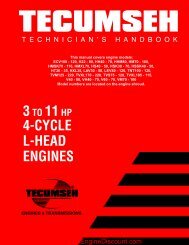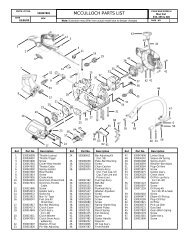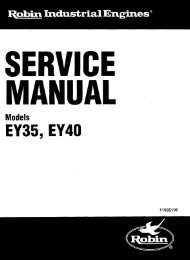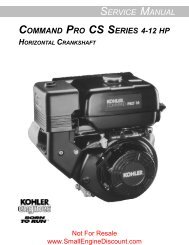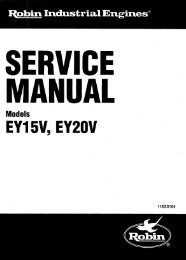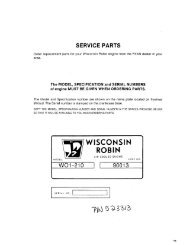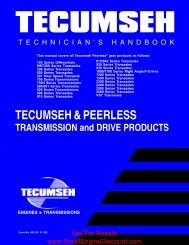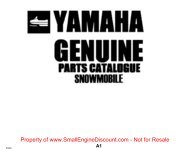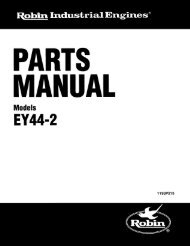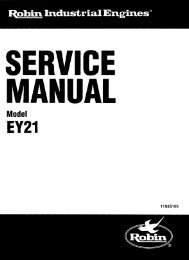4-CYCLE OVERHEAD VALVE ENGINES - Small Engine Discount
4-CYCLE OVERHEAD VALVE ENGINES - Small Engine Discount
4-CYCLE OVERHEAD VALVE ENGINES - Small Engine Discount
Create successful ePaper yourself
Turn your PDF publications into a flip-book with our unique Google optimized e-Paper software.
PISTONS, RINGS, AND CONNECTING<br />
RODS<br />
Piston<br />
The piston should be checked for wear by measuring<br />
near the bottom of the skirt 90 degrees from the piston<br />
pin hole with a micrometer. Check the ring side<br />
clearance using a feeler gauge with a new ring. Clean<br />
all carbon from the piston top and the ring grooves<br />
before measuring. Visually inspect the piston skirt area<br />
for scoring or scratches from dirt ingestion. If scoring<br />
or deep scratches are evident, replace the piston.<br />
If the cylinder bore needs re-sizing, an oversize piston<br />
will be necessary. Oversize pistons are identified by<br />
the imprinted decimal oversize value imprinted on the<br />
top of the piston (diag. 27).<br />
INDICATES<br />
.010" (.254 mm) OVERSIZE<br />
PISTON<br />
PISTON MEASUREMENTS ARE TAKEN AT<br />
BOTTOM OF SKIRT 90 0 FROM WRIST PIN HOLE<br />
27<br />
Piston Rings<br />
After the cylinder bore diameter has been checked<br />
and is acceptable to rebuild, the ring end gap should<br />
be checked using new rings. Place a new compression<br />
ring squarely in the center of the ring travel area. Use<br />
the piston upside down to push the ring down (diag.<br />
28) and measure the gap with a feeler gauge. The<br />
ring end gap must be within the specification to have<br />
adequate oil control (diag. 29). This procedure will<br />
assure correct piston ring end gap measurement. Ring<br />
side clearance should also be checked with a feeler<br />
gauge when using new rings with an old piston (diag.<br />
30).<br />
Replace the rings in sets and install the piston, rings,<br />
and rod assembly in the cylinder bore with the ring<br />
end gaps staggered. When installing new rings in a<br />
used cylinder, the cylinder wall should be de-glazed<br />
using a commercially available de-glazing tool or hone.<br />
Use a ring expander to remove and replace the rings.<br />
Do not spread the rings too wide or breakage will result.<br />
Piston Ring Orientation<br />
If the top compression ring has an inside chamfer,<br />
this chamfer must face UP. The second compression<br />
ring will have either an inside chamfer or an outside<br />
notch. The rule to follow is an inside chamfer always<br />
faces up. An outside notch (diag. 31) will face down<br />
or towards the skirt of the piston.<br />
The oil control ring can be installed with either side<br />
up. The expander (if equipped) end gap and the ring<br />
end gap should be staggered (diag. 31).<br />
NOTE: Always stagger the ring end gaps on reassembly.<br />
CYLINDER<br />
CHAMFER<br />
EMISSION RINGS<br />
PISTON<br />
PISTON RING<br />
28<br />
29<br />
1ST COMPRESSION RING<br />
2ND COMPRESSION RING<br />
3RD OIL<br />
CONTROL RING<br />
30<br />
1ST COMPRESSION RING<br />
2ND COMPRESSION RING<br />
3RD OIL<br />
CONTROL RING<br />
31<br />
70<br />
Not For Resale<br />
www.<strong>Small</strong><strong>Engine</strong><strong>Discount</strong>.com




